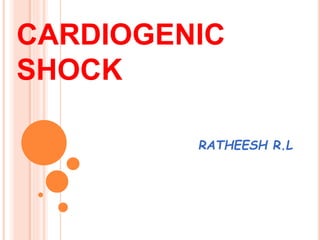
Cardiogenic shock
- 2. INTRODUCTION Shock is a failure of the circulatory system to maintain adequate perfusion of vital organs.
- 3. TYPES OF SHOCK Neurogenic shock Septic shock Anaphylactic shock Hypovolemic Shock Cardiogenic Shock
- 4. CARDIOGENIC SHOCK Cardiogenic shock occurs when the heart is unable to function adequately resulting in insufficient blood flow to tissue and organs.
- 5. ETIOLOGY • Acute Myocardial Infarction • Sepsis • Myocarditis • Endocarditis • Myocardial contusion • Aortic or mitral stenosis • Acute aortic insufficiency • Cardiac rupture • Peripheral vascular disease
- 6. Cerebrovascular diseases Hypertrophic cardiomyopathy Acute mitral regurgitation Endocarditis Post cardiac surgery Pneumothorax Suppression of myocardial contractility(beta blockers)
- 8. CLINICAL FEATURES Chest Pain Nausea And Vomiting Dyspnea Cyanosis Excessive Sweating Confusion Restlessness Mental Lethargy Palpitation Syncope Cold, Clammy Skin
- 9. Slow Capillary Refill Weak Thready Peripheral Pulses Hypotension Bradycardia/Tachycardia Distention Of Neck Veins Peripheral Edema Murmer Pulmonary Crackles/Wheeze Oliguria Altered Mental Status
- 10. DIAGNOSIS History Collection • Recent illness • Fever • Chest pain, SOB • Abdominal pain • Comorbidities • Medications • Toxins/Ingestions • Recent hospitalization or surgery • Baseline mental status
- 11. Physical examination • Vital Signs • CNS – mental status • Skin – color, temp, rashes, sores • CV – JVD, heart sounds • Respiratory – lung sounds, RR, oxygen sat, ABG • GI – abd pain, rigidity, guarding, rebound • Renal – urine output
- 12. ECG ECHOCARDIOGRAPHY CORONORY ANGIOGRAM LABORATORY STUDIES Complete blood count Arterial blood gas monitoring Cardiac enzyme tests
- 13. GOALS OF TREATMENT • ABCD • Airway • control work of Breathing • optimize Circulation • assure adequate oxygen Delivery
- 14. AIRWAY • Determine need for intubation but remember: intubation can worsen hypotension • Sedatives can lower blood pressure • Positive pressure ventilation decreases preload • May need volume resuscitation prior to intubation to avoid hemodynamic collapse
- 15. CONTROL WORK OF BREATHING • Respiratory muscles consume a significant amount of oxygen • Mechanical ventilation and sedation decrease WOB and improves survival
- 16. OPTIMIZING CIRCULATION • Isotonic crystalloids • maintain: • CVP 8-12 mm Hg • Urine output 0.5 ml/kg/hr (30 ml/hr) • Improving heart rate • May require 4-6 L of fluids • No outcome benefit from colloids
- 17. MAINTAINING OXYGEN DELIVERY • Decrease oxygen demands • Provide analgesia and anxiolytics to relax muscles and avoid shivering • Maintain arterial oxygen saturation/content • Give supplemental oxygen • Maintain Hemoglobin > 10 g/dL • central venous oxygen saturations to assess tissue oxygen extraction
- 18. THEN…… * Positioning the recommended position for the patient in shock is supine with legs elevated 45 degrees.
- 19. MANAGEMENT OF SHOCK Vasoconstrictors Dopamine Norepinephrine Vasodilators Nitroprusside Nitroglycerin Sympathomimetics Epinephrine Corticosteriods Hydrocortisone sodium Appropriate antidotes or antibiotics * Pharmacologic Management
- 20. OTHER METHODS INTRA AORTIC BALLOON PUMP This device is placed in the aorta, the main blood vessel that carries blood from the heart to body. This balloon is inflated and deflated in a rhythm that exactly matches the rhythm of heart. This helps the weakened heart muscle to pump as much as blood to other organs of the body.
- 21. Angioplasty and stent Angioplasty is a procedure used to open narrowed or blocked coronary arteries. A stent is a small tube that placed in coronary artery during angioplasty to keep the artery open.
- 22. SURGERY Coronary artery bypass graft Surgery to repair an injured heart Heart transplantation
- 23. NURSING MANAGEMENT Identify patients at risk for development of cardiogenic shock Assess the early signs and symptoms of cardiogenic shock Assess the mental status of the patient Monitor vital signs frequently Check the peripheral pulses Observe for edema in the lower extrimities
- 24. Maintain an intake-output chart Observe the signs of peripheral cyanosis Assess the heart and lung sounds Monitor for chest pain and diaphoresis Provide psychological support to the patient and relatives.
- 25. NURSING DIAGNOSIS Decreased cardiac output related to impaired cardiac contractility as evidenced by hypotension. Impaired gas exchange related to pulmonary congestion as evidenced by decreased oxygen saturation levels Impaired tissue perfusion related to decreased cardiac contractility and blood flow as evidenced by increased capillary refilling time >3 seconds
- 26. Fear and anxiety related to intensive care environment as evidenced by fearful facial expression Activity intolerance related to decreased cardiac activity and laboured respirations as evidenced by difficulty in performing activities of daily living
- 27. Imbalanced nutrition less than body requirement related to breathlessness as evidenced by weight loss Disturbed sleep pattern related to shortness of breath as evidenced by presence of dark circles around the eyes.